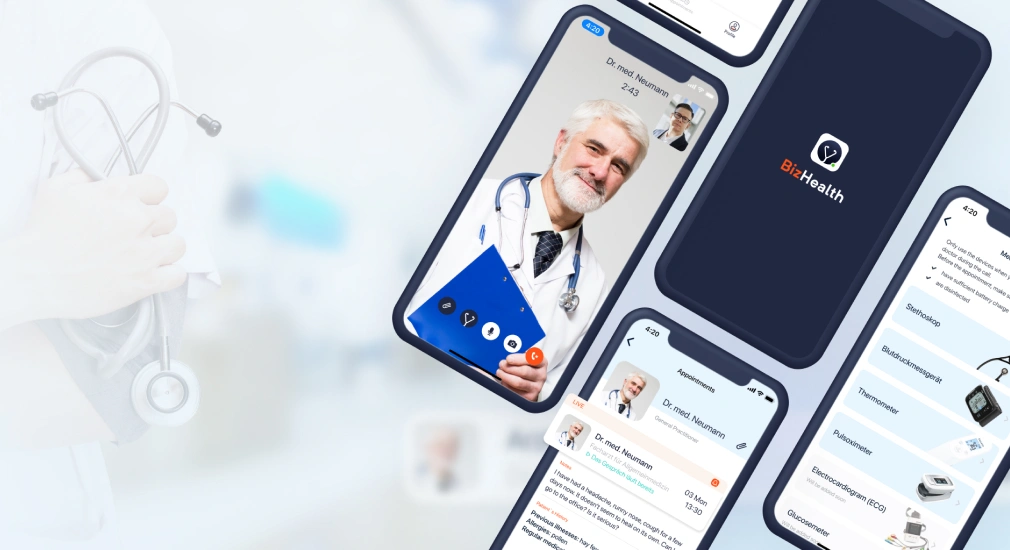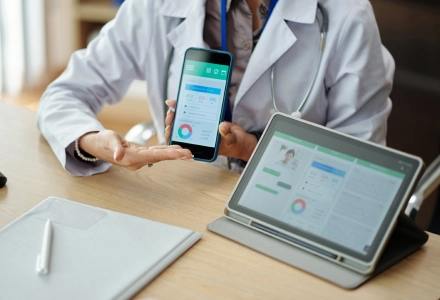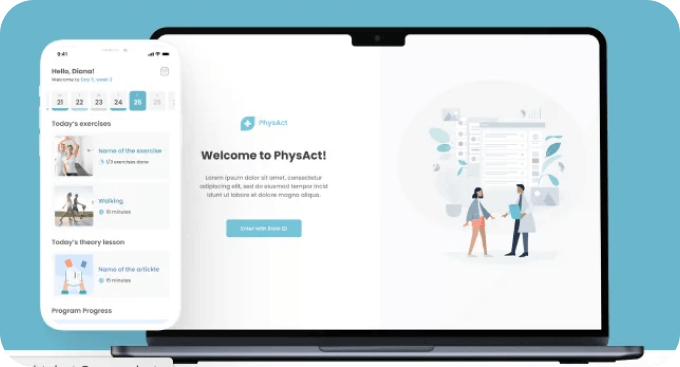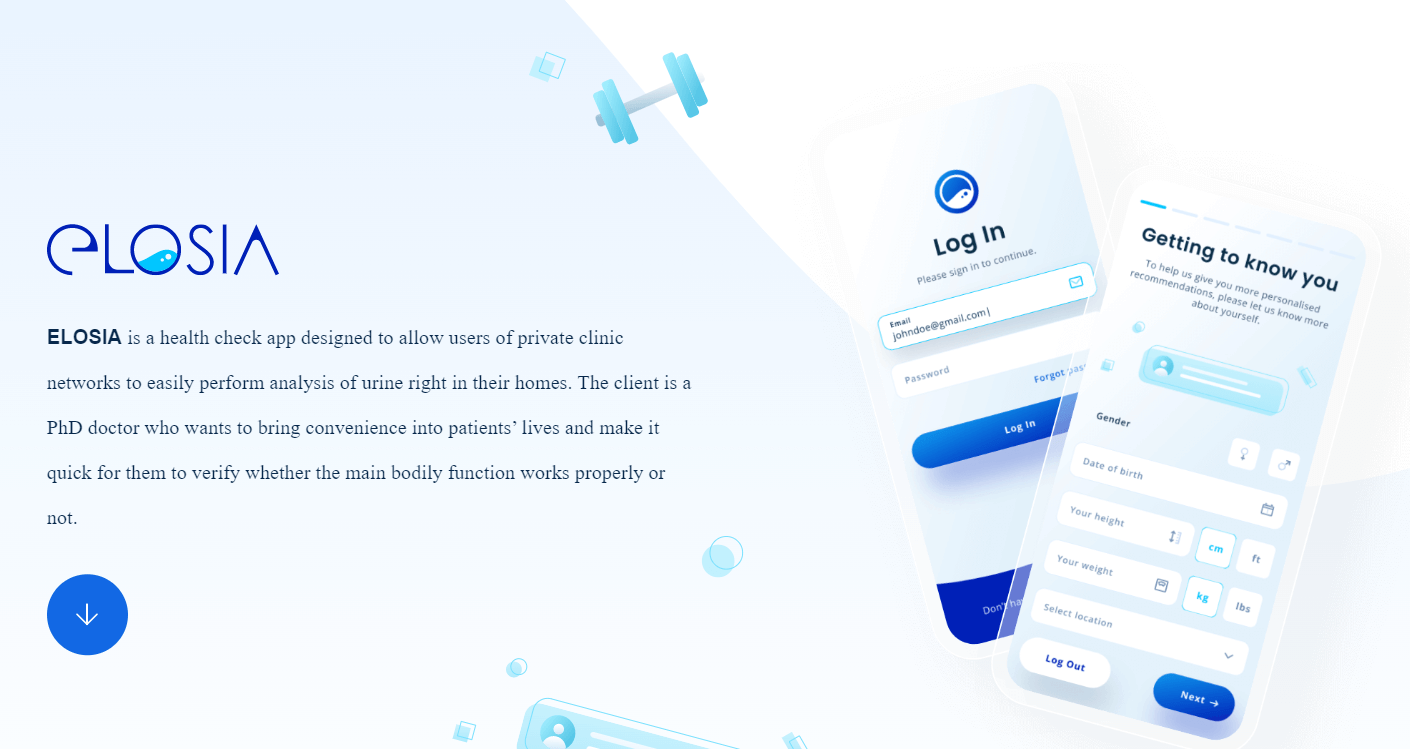According to statistics, in 2020, the digital health market was $216 billion, and by 2025 this number will more than triple. Is this not a reason to think about developing your solution based on telehealth technologies?
Below we will tell you about the types of mobile health solutions and give an example from our practice. If you want to hire a dedicated team of developers who are eligible to implement different types of telemedicine applications, just contact Interexy.
What is Telehealth?
Telehealth is a special software for the modern digital equipment (PCs, wearables, smartphones, etc.) through which some healthcare services are provided. Typically, these solutions use video conferencing, telephony, or streaming audio and video capabilities, as well as current IT trends like virtual or augmented reality, artificial intelligence, the Internet of Things, etc.
Therefore, telehealth usually includes:
- Video conferencing. With the help of this feature, doctors can examine patients from a distance, and teachers can give lectures to their students;
- Storing and transferring data. This feature usually opens access to archives with reference materials that are needed in the examining process or learning in medical institutions;
- Mobile features. These are all the features that make the software mobile: sending push notifications, access to the camera and contacts, counting heart rate and number of steps, etc.;
- Remote patient monitoring (RPM). These features are inherent in specialized devices that can record the patient’s clinical vital signs, such as blood pressure or pulse rate. Let’s explore how to create mobile patient monitoring.
As for the telehealth and telemedicine difference, the second concept is narrower and consists only in the provision of telemedicine assistance. Usually, all types of telemedicine applications work as an alternative to traditional offline physician visits. That’s why the term “telehealth” is considered much broader, not only in healthcare provision but also in education and health education.
Problems of Existing Telehealth Solutions
Interoperability is essential for the long-term development of telehealth, but practical implementation of different types of specialty services in telemedicine is difficult for many reasons. The following three problems should be highlighted:
- too broad definition of the term telehealth;
- lack of standards explicitly created for the telehealth sector;
- insufficiently coordinated cooperation between information and telecommunication companies.
Thus, as yet, there is no official standard for telehealth. Telehealth is still using technical standards developed for various sectors, including multimedia conferences, information technology, data exchange and healthcare data integration, and medical data security. They are mainly focused on functional and performance requirements and do not provide interoperability between different telehealth systems. Additional challenges stem from the fact that all of these telehealth technology standards and needs are constantly changing.

5 Types of Telemedicine Apps
Now let’s describe the main types of telehealth app development.
1. Live Video Conferencing Apps
As for the question: “What are the two types of telemedicine technologies?” we can define live and asynchronous video software solutions.
Basically, the first type of application (with real-time video-conferencing) is a more modern alternative to live doctor consultation, allowing such services to be implemented remotely. This software also allows exchanging data between students and teachers in teaching medical institutions and conducting live lectures and conferences. In general, any application with video streaming capabilities is suitable for this purpose (for instance, it could be Zoom). Still, there are some different telemedicine applications for healthcare that doctors use more often than others. One of the most famous examples of these apps is TrueConf.
2. Asynchronous Video (Store-and-Forward) Apps
These apps are the second type of two types of applications for telemedicine that allow healthcare providers or particular doctors to share training images and videos for students or other doctors in the remote mode. They provide 24/7 access to these materials, simplifying the learning or diagnostics process.
Reach out to us for crafting a user-centric app that is worth a thousand downloads!
Let's talk3. Remote Patient Monitoring (RPM) Apps
Due to the increased popularity of the IoT concept, it is not surprising that the range of related technologies has also touched the healthcare sector. In particular, wearables like FitBit bracelets and Oura Ring have been in demand for many years now. It is also obvious that many diseases in our time require constant monitoring (at least from the patient’s side in order to seek medical attention promptly). In particular, we are talking about heart disease, stroke, epilepsy, and critical health conditions.
So, instead of hiring a personal nurse (which is a relatively expensive and irrational measure), where to equip each patient with a corresponding solution-tracker, whose work in practice is devoid of the human factor.
For the same purpose, artificial intelligence can be involved, based on which preliminary diagnoses can be made. These diagnoses can induce patients to turn (or refrain from turning) to the appropriate specialist. Therefore, these types of telemedicine apps reduce the burden on doctors and simplify the examination process (since, in that way, they will have data on the patient’s health indicators) due to the already existing diagnosis conclusion.
For example, today, the IBM Watson for Health solution uses knowledge from tens of thousands of medical reference books worldwide. Also, this tool can independently analyze the indicators of patients’ health, simplifying the diagnostic process and eliminating the need to collect anamnesis data.
4. Mobile Health (mHealth) Apps
This type of software directs patients to the appropriate specialists based on their work schedule and already busy appointment hours. This means that it will help expand the services of medical centers or entire city infrastructures. Typically, such applications have the option to create a personal patient account. They also support push notifications that remind patients of upcoming visits, regardless of their activity mode. From the most famous examples of telemedicine applications, we can single out MedKitDoc.
5. Apps for Distance Education for Providers
Modern online medical guides use VR, AR, or 360-degree video as technological solutions with tremendous potential. For example, virtual reality can be an excellent alternative to physical 3D models and living samples, making the process of training surgeons more humane and convenient in terms of mobility. But such solutions require special equipment — virtual reality glasses.
The AR concept is also used in medical education. These technologies allow viewing objects, phenomena, and organs in a three-dimensional format directly from a user’s smartphone screen. Also, augmented reality gives hints when interacting with medical equipment or during operations.
For example, the EyeDecide app, with the help of the user’s smartphone camera display, simulates the impact of particular environmental conditions on the patient’s vision, helping the physicians make correct diagnoses.
Interexy’s Experience in Telemedicine and Telehealth App Development
MedKitDoc
Interexy developed MedKitDoc, an innovative telemedicine app designed to bridge the gap between physicians and patients with advanced technology. The app complies with strict healthcare and security standards, integrating Bluetooth-enabled medical devices for real-time health data and expanding telemedicine capabilities.
Our team delivered a sleek and intuitive platform with separate flows for patients and physicians, focusing on user experience and robust UI. MedKitDoc transforms patient care and empower healthcare professionals with modern tools, redefining how telemedicine works.

AcneAway
Interexy partnered with AcneAway, a New York-based telemedicine startup, to develop a web-based MVP for seamless online dermatology consultations. Focused on treating acne, AcneAway connects patients with dermatologists for quick diagnoses and personalized treatment plans. Our team implemented AI-powered scheduling, intuitive UI/UX, and robust backend technologies like AWS and NodeJS to ensure efficiency and reliability.

Final Thoughts
We hope that we answered the question: “What are the types of telemedicine apps?” And now, let’s summarize. In general, the development of digital technologies has radically changed the process of providing medical care. Patient-centered service offers favorable conditions for the further development of information technology in the healthcare sector and positive growth dynamics of this market segment. In particular, telehealth is seen as the future of healthcare, due to which it continues to grow rapidly.
If you are interested in creating an application based on the telehealth concept with the help of latest technology trends in healthcare, contact our company. Our professionals with broad expertise in telehealth application development will provide a personalized approach tailored to your solution. So, don’t hesitate and contact us!
Know more about our referral program





